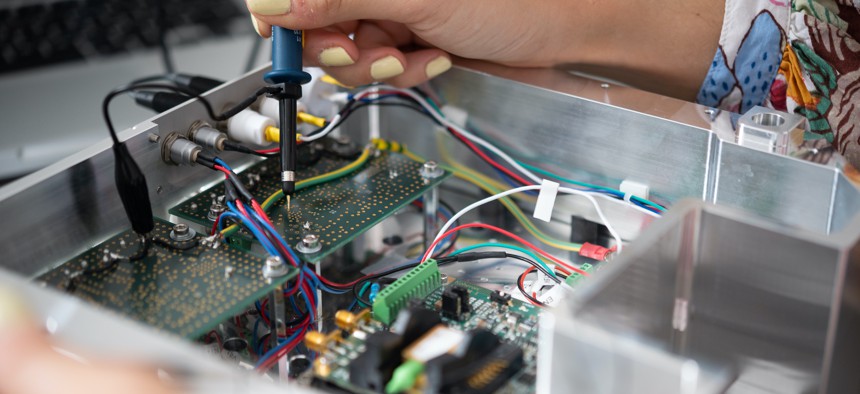CHRIS JAY HOOFNAGLE and SIMSON GARFINKEL

Much ink has been spilled about quantum computers, particularly in overblown claims that quantum cryptanalysis will someday shred today’s encryption techniques. But their simpler cousins—quantum sensors—are here now and improving at a rate that demands urgent attention.
Quantum sensors use the smallest amounts of energy and matter to detect and measure tiny changes in time, gravity, temperature, pressure, rotation, acceleration, frequency, and magnetic and electric fields. They’ve been commercially available in various forms for more than a half-century; think of a magnetic resonance imaging, or MRI, machine, which tracks flips in the magnetic spin of individual hydrogen atoms to peer into a body. But recent progress in the field suggests that such sensors will soon bring a revolution in measurement and signals intelligence—possibly by making it far easier to detect submarines, spacecraft, and underground facilities.
Strategists must understand the new capabilities that quantum sensing will provide and start planning countermeasures today. Here are three examples that help explain why.
Measuring time
Ultra-precise timekeeping is the most important quantum-sensing achievement to date, for it adds precision to all other forms of sensing. For instance, it allows us to make repeated observations and combine them, an approach that is sometimes called “super resolution.” Think of the way today’s photographers take four or eight photos of the same scene and then combine the images using software. Better timing allows the same kind of thing with all kinds of measurements.
The atomic clocks of the 1970s that underlie the Global Positioning System and its attendant revolution—and miniaturized atomic clock are becoming commercially available. Microsemi Corporation, for example, sells a 35-gram “space chip scale atomic clock.” Laboratories are working on even better timing technology that promises to be just as transformative. In 2018, NIST announced a breakthrough: a clock based on a lattice of ytterbium atoms so sensitive that it wouldn’t drift more than a second in 10 billion years.
Location, location, location
Beyond making super-accurate GPS, quantum sensors can measure the shape and gravitational field of Earth to within a centimeter. Such sensing can be useful both for mapping out underground mineral resources and for precisely calculating the trajectories of ballistic missiles and other munitions.
Militaries have long sought ways to get extremely precise location data without using easily jammed GPS-type signals at all. Quantum positioning sensors track minute changes to rotation and acceleration, using Newton’s laws (adjusted for relativity) to accurately infer changes to location over time. Because they do not depend on signals from satellites or ground stations, they work anywhere—indoors, underground or underwater—and resist jamming. Defense contractors are starting to make portable QPS packages that could fit into weapons.
Seeing through walls and water
Advances in quantum radar and sonar research have rattled some policymakers because they may allow enemies to detect stealthy aircraft and warships and to distinguish legitimate radar targets from decoys.
Quantum radar would work by generating billions of "entangled" photon pairs, sending one photon from each pair into the search area while retaining the other in memory. “Signal” photons reflected back to the sensor are then compared to their “idler” mates, revealing information about airborne objects. Unlike conventional radar, such sensors promise to be largely immune to jamming and even detection by an adversary. In space, where photons are less likely to be scattered, quantum radar might be used to detect ballistic missiles, discover adversaries’ secret satellites, and spot and track tiny-but-still-dangerous space junk. There are engineering challenges, but theoreticians believe these are surmountable, and recent developments suggest approaches that could produce practical results.
Quantum sensing’s threat to the status quo is more dire underwater. The Chinese military has reportedly developed next-generation, sonar-like systems that can detect submarines and even underground objects. Other publications describe how Chinese scientists used precise measurement of time and location to fly a magnetometer over a field and detect buried iron balls based on their perturbations of the Earth’s magnetic field.
Such devices should eventually be able to detect the existence of underground tunnels or structures, and even the movement of military matériel or drugs through such tunnels. They might also allow the detection and tracking of America’s previously all-but-undetectable ballistic missile submarines and thereby destabilize nuclear deterrence.
Conclusion
The importance of quantum sensors has largely eluded policymakers, even though the technology has been improving for decades. Part of the reason is surely the hype surrounding quantum computers, whose challenges to practicability include their need to be shielded from interacting with the rest of the universe until its computation is complete. But quantum sensors, which put this extreme sensitivity to use, are here today and rapidly getting better.
The coming decades will be defined by greater reliance on measurement and sensing intelligence, brought about by electromagnetic and gravimetric quantum sensors that can see through barriers. Militaries may soon find it impossible to hide matériel and current secrecy strategies, such as using underground facilities, may be rendered ineffective.
Security policymakers must keep their eye on quantum sensing advances and their implications. And they must ask what it will mean when this technology leaves intelligence and military agencies and becomes in reach of law enforcement agencies, private companies, and wealthy individuals.
No comments:
Post a Comment